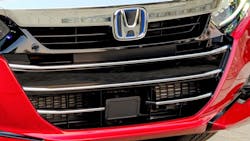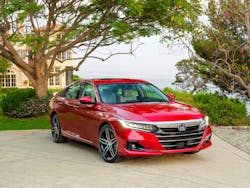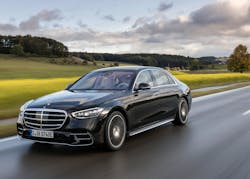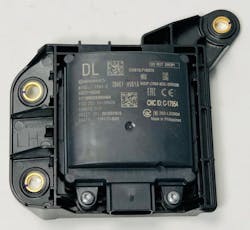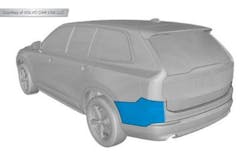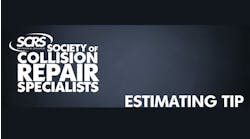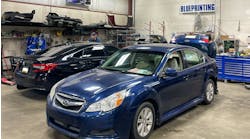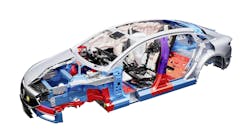The announcement by some OEMs in recent years prohibiting repairs on some plastic bumper covers due to the presence of ADAS sensors seems to have made everyone a bit jumpy about the topic. Since many technicians are not really thrilled with the prospect of having to do plastic repairs anyway, the OEM announcements became a convenient scapegoat for their reluctance.
Unfortunately, this reluctance has a real cost in terms of cycle time, severity, and environmental impact. Just a bit of education on the topic is all that’s needed to dispel some of the fear and trepidation around the relationship between plastic repair and ADAS sensors.
First of all, let’s get clear about the different types of sensors used on today’s vehicles. There are optical sensors (binocular computer vision systems) mounted up at the top of the windshield that aren’t an issue with regard to plastic repair, so no worries there. There are radar and lidar-based technologies used for a vehicle’s adaptive cruise control, automated emergency braking (AEB), and forward collision warning (FCW) systems that are usually centrally mounted in the grille or bumper.
These sensors are normally easy to identify because their signals must pass through uncoated glass or plastic, not a painted bumper cover. Often, they are mounted in the middle of the grille under a piece of plastic made to look like the grille, such as on the Mercedes Benz S-Class sedan below, or the standalone sensor in the lower grille on the Honda Accord.
There are three types of sensors you need to be concerned about with relation to plastic bumper repair – sonar, radar, and pneumatic.
First of all, there are just a couple of pneumatically actuated systems behind the front bumper cover that detect a pedestrian collision and instantly pop the hood up to mitigate the impact. These would be on the 2018-2020 Buick Regals and the 2019 to current VW Arteon. OEM procedures prohibit repair of these plastic bumper covers because a repair could alter the effectiveness of the sensor. Researching the OEM procedures is always a necessary first step when deciding whether a plastic repair can be done or not.
Sonar-based sensors are the round ones about the size of a penny that protrude through the bumper fascia. These are short-distance proximity sensors that use sound waves to measure the distance to objects near the vehicle. These are typically used for parking and backup sensors. Doing a repair on the bumper fascia near a sonar-based sensor should not be a problem because the sensor itself protrudes through the bumper.
Radar-based sensors are more powerful and are used to sense objects farther away. We’ve already discussed where the radar-based sensors are on the front of the vehicle. On the rear of the vehicle, they are used for blind spot and cross-traffic monitoring. These are typically mounted behind the bumper fascia and project their signals through it. These are the sensors you need to be most aware of when deciding whether to make a repair on a plastic bumper cover.
Considering any radar-based sensor which passes its signals through the plastic bumper fascia, understandably the OEMs are wary of anything which might affect the signal in either direction. For this reason, most OEMs prohibit refinish or repair operations in the general area of the bumper around where the sensors are mounted. Some OEMs even go so far as to prohibit any repair or refinish operations done anywhere on the bumper.
So, what should the collision repairer do? First of all, and most importantly, research the OEM’s repair procedures to see what areas of the bumper fascia are affected by a repair prohibition. In most cases, there will be a dimensioned diagram showing the area that cannot be repaired, such as shown in this image of a Volvo rear bumper.
If the OEM procedures are not clear, then use your judgment. If there is a radar-based sensor behind the bumper fascia in the damaged area, replace the bumper. Any material used which increases the thickness of the bumper in the damaged area will certainly affect the signals being sent and received by the sensor. This includes plastic welding rod, metal reinforcing mesh, adhesives, fillers, and refinish coatings.
If the OEM procedures allow repair in the damaged area, or if the damage is in an area well away from any underlying radar sensors, then a safe repair may be performed. Plastic repair can be performed using any number of methods, from welding to adhesives, depending on the skill, experience, equipment, and consumables available to the collision repair technician.
The bottom line is, when considering a plastic repair on a bumper cover with radar-based sensors mounted behind, first follow the OEM procedures, and if those aren’t clear, stay well away from the sensors. And keep in mind that plastic repair is not just limited to bumper covers; practically any damaged plastic part on the vehicle can be repaired if it creates an outcome beneficial to all parties. Having the equipment, supplies, and training to repair damaged plastics is the first step to taking advantage of such opportunities.
